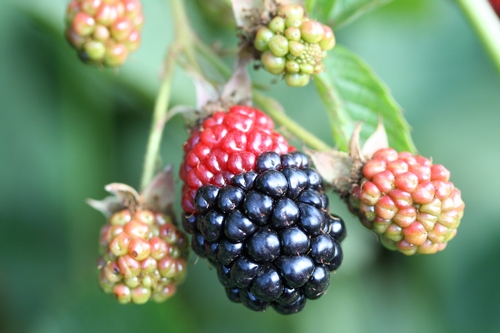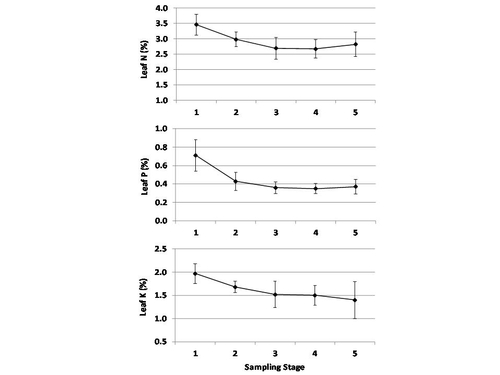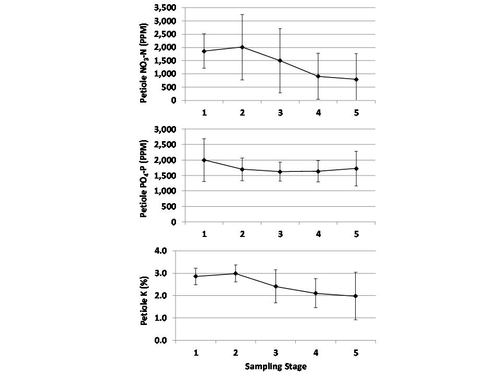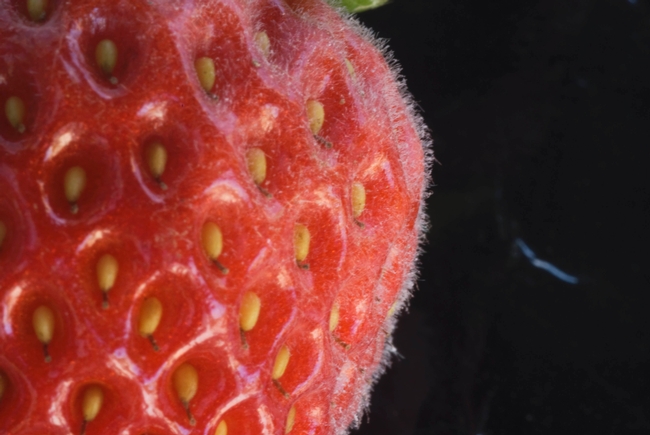
Posts Tagged: sulfur
Sulfur could be related to cases of asthma near farming communities
Sulfur is a natural element that can be used in strawberries, grapes and other crops to protect fruit from powdery mildew, a fungal disease that results in damaged fruit, reported Eilis O'Neil on Reveal, a podcast produced by the Center for Investigative Reporting and PRX.
Because sulfur is natural, it can be used by organic and conventional farmers alike. And it is inexpensive.
"Farmers use tons of it," O'Neill said. "It's the most used pesticide in California and it's widely used in the rest of the country."
However, it is an irritant. People who accidentally breath it in can have irrigated eyes, sore throats or difficulty breathing.
O'Neil interviewed Lisa Blecker, a pesticide safety coordinator with the UC Statewide Integrated Pest Management Program (UC IPM). UC IPM is part of UC Agriculture and Natural Resources.
"There's something about sulfur that makes people (react more strongly) every time that they're exposed to sulfur ... kind of like if you are allergic to a bee sting. So every subsequent time that you are stung, your body responds in a more severe way," Blecker said.
Brenda Eskenazi, a public health researcher at UC Berkeley, also appeared on the podcast. She said she had seen case reports about an increase in asthma symptoms in children who live near fields where sulfur was sprayed. Eskenazi and her colleagues followed the health of more than 500 children in the Salinas Valley from pre-birth to 7 years old.
"Kids that lived closer to where sulfur was applied had more asthma problems and also poorer lung function," Eskenazi said.
Blecker said that sulfur must be closely regulated.
"Anything that we do to reduce the offsite movement of pesticides is good, (such as) monitoring wind speed and direction," Blecker said. "A lot of grape growers do night applications because they are trying to just minimize the exposure to people because there's more people out during the day. If you're spraying in a situation where grapes are only on one side of you, it's best to be spraying into the vineyard."
It's Time to Spray for Peach Leaf Curl in Wet Winter Climates
Winter slows down many garden pest problems, but it's also a key time for gardeners to take actions...
Sulfur and Plant Disease
The element sulfur (S) has a large role in the management of plant disease. Growers are familiar with the biocidal formulations of sulfur, being elemental sulfur, sulfides, thiosulfate and fumigants like dimethyldisulfide (DMDS) and of course then we have sulfur dioxide which has been used as a postharvest preservative for dried fruits and vegetables.
However, beyond these outright biocidal effects we get from use of sulfur as a fungicide, there is also significant literature concerning the indirect effects of sulfur nutrition on reinforcing a plant's ability to inhibit and resist disease. Known as “Sulfur Induced Resistance” this is how one should frame the role of sulfur incorporated as a nutrient in plant response to disease.
There could be something to this. Work has been done showing that higher rates of S fertility affected infection rates and severity of fungal disease in oilseed rape and stem canker of potato. While informative, it is significant that the results of the former were achieved by sulfur additions to a field that was deficient.
How would sulfur induce resistance or inhibit disease in a plant? Sulfur goes to many places, including the amino acids acids cysteine and methionine, which are in 99% of proteins found in a plant. Findings cited by the chapter report that sulfur deficiency in the plant result in lower protein bound cysteine and free cysteine, which as the precursor to all relevant sulfur containing metabolites must have something to do with the ability to resist or inhibit disease.
Sulfur also goes to non-protein reservoirs in the plant, one of the main ones being glutathione. Glutathione, known as a phytoalexin because it is not formed prior to disease incursion, nevertheless accumulates rapidly after pathogen attack. It is involved in detoxifying signals necessary for fungal growth and could also be serving as a messenger to carry information to yet unaffected plant cells.
Phytoanticipins, in contrast to phytoalexins, are molecules in the plant which are preformed antibiotics- i.e. the plant produces them whether or not there is disease. Glucosinolates (of which our well known isothiocyanates are a cleaved product), on which sulfur plant nutrition has a strong influence, are one of these antibiotic phytoanticipins. Interestingly, low concentrations of glucosinolates don't necessarily equate with higher disease susceptibility, making them more of a qualitative defense for the plant.
Bottom line: The role of sulfur in disease resistance and inhibition in plants is a very important one, but it's a pretty sure thing that these systems function perfectly well in sulfur sufficient soils, which describe pretty well every one in the Pajaro and Salinas Valleys. As such, while the value of sulfur as a foliar fungicide is indisputable for certain diseases, I am not seeing the value of pursuing sulfur work experimentally as a soil disease mitigant.
The above is a summary of some of the aspects of Chapter 8: Sulfur in Plant Disease from “Mineral Nutrition and Plant Disease” edited by Lawrence Datnoff, Wade Elmer and Don Huber.
Utility of Fall Applied Lime Sulfur in Reducing Incidence of Redberry Mite in Blackberry
As readers of this space already know, the utility of fall applied lime sulfur for controlling redberry mites in blackberries has been questioned. Previous collaborative work has shown that 3-4 applications of Golden Pest Spray oil at a dilution of 1.2 – 2% volume to volume applied at the 50% green fruit stage in the spring is the most effective way to control this pest in blackberry.
This past year, the authors partnered to test the thesis that fall applied lime sulfur, with and without flowable sulfur, would not have an effect on total redberry mite infestation later on in the season. The trial consisted of each treatment (no winter application, 15 gal/A lime sulfur applied twice, and 15 gal/A lime sulfur + 10 lb/A flowable sulfur applied twice) being replicated four times. In turn, each treatment replicate plot was composed of three side by side 250 foot long tunnels, with each tunnel covering three rows of blackberries (meaning each treatment replicate had nine rows of blackberries).
First application of 15 gal of lime sulfur and 15 gal of lime sulfur + 10 lbs wettable sulfur was made November 18, 2013 and the second application of the same was made January 17, 2014. In the spring, two applications each were made of of wettable sulfur (12 lbs per acre) and Golden Pest Spray oil (1.5% to 2%). All other crop and pest management procedures were made as necessary to the maintenance of the crop.
Starting June 29 and continuing weekly through the end of July for a total of six evaluations, total number of marketable fruit and redberry mite fruit were counted in a four foot long section of each three tunnel replicate plot. Statistical evaluation was done as a percentage redberry mite infested fruit compared to total amount of fruit.
As the reader can see from the data presentation below, lime sulfur used either alone or lime sulfur applied with sulfur had no effect on redberry mite incidence in the field in this study. While it is to be noted that this is a single trial run in a drought year, it nevertheless adds a good data set to the consideration of the question of the utility of fall sulfur applications for redberry mite.
|
Evaluation date |
%RBM affected fruit 6-29-2014 |
%RBM affected fruit 7-3-2014 |
%RBM affected fruit 7-10-2014 |
%RBM affected fruit 7-17-2014 |
%RBM affected fruit 7-24-2014 |
%RBM affected fruit 7-31-2014 |
|
No Winter Treatment |
2.66 |
2.66 |
3.32 |
5.01 |
12.50 |
11.99 |
|
15 gal/acre lime sulfur |
1.70 |
2.81 |
3.25 |
7.23 |
9.44 |
16.93 |
|
15 gal/acre lime sulfur + 10 lb/acre flowable sulfur |
1.94 |
3.20 |
3.73 |
7.69 |
11.82 |
13.06 |
None of the means of the percentages of redberry mite infested fruit differ significantly at the 5% level.

Redberry mite affected blackberry fruit. Note clear demarcation between affected, unripe druplets and those which are not.
Strawberry Plant Nutrient Sufficiency Levels Revised
It has been more than 30 years since UC published strawberry leaf nutrient diagnostic guidelines (Publication 4098, ‘Strawberry deficiency symptoms: a visual and plant analysis guide to fertilization’, released in 1980). In the years since that publication, varieties, production practices and yield expectations have changed considerably. In 2010 we began a project, funded by the California Strawberry Commission, to reevaluate leaf and petiole nutrient sufficiency ranges for day-neutral strawberries. With the cooperation of many berry growers in the Watsonville-Salinas and Santa Maria areas we collected leaf and petiole samples from more than 50 ‘Albion’ fields over the past two production seasons. In each field samples were collected 5 times over the production season, from early spring through September, to document the nutrient concentration trends from pre-fruiting to post-peak production. Leaf samples were analyzed for total concentration of nitrogen (N), phosphorus (P), potassium (K), calcium (Ca), magnesium (Mg), sulfur (S), zinc (Zn), manganese (Mn), iron (Fe) and copper (Cu). Petioles were analyzed for NO3-N, PO4-P and K concentration.
After the season cooperating growers provided yield information, which allowed us to categorize the fields as being ‘high yield’ or 'low yield’. We then applied a process called DRIS (Diagnosis and Recommendation Integrated System) to mathematically evaluate the difference in nutrient concentrations as well as nutrient ratios between high yield and low yield fields. This process allowed us to identify which of the high yield fields were ideally balanced nutritionally. From this group of nutritionally balanced, high yield fields we were able to calculate a DRIS sufficiency range for each nutrient at each growth stage.
Fig. 1 shows that leaf N, P and K concentrations were highest before harvest began (stage 1, which was late February in Santa Maria and late March in Watsonville-Salinas), and declined to a reasonably stable level throughout the main harvest period (stages 3-5, May-July in Santa Maria, June-August in Watsonville-Salinas). The decline in leaf macronutrient concentrations during the peak harvest period was expected; it happens in many fruiting crops because the leaves rapidly translocate nutrients to the developing fruit. By contrast, micronutrient concentrations either increased from early vegetative growth to the main harvest period (as was the case for B, Ca and Fe), or remained reasonably stable over the entire season (all other micronutrients). The vertical bars on each data point on Fig. 1 indicate the range of values typical of nutritionally balanced, high yield fields at each growth stage. These are the DRIS sufficiency ranges; leaf nutrient concentrations within these ranges can safely be assumed to be adequate for high yield production.
Table 1 lists the DRIS leaf nutrient sufficiency ranges for pre-harvest and main harvest growth stages. For the sake of comparison, both the sufficiency ranges given in UC Publication 4098 and the current University of Florida guidelines have been included. Although for most nutrients the ranges match pretty well, for others there are substantial differences. Where the DRIS sufficiency range is substantially higher than the other sources (Ca, Mn and Fe, for example) it is because those nutrients are in such abundant supply in our coastal soils that plant uptake is far in excess of actual plant requirement; for those nutrients a lab test result marginally below the DRIS range would not be a matter of concern.
For several nutrients (N, Zn and Cu) the DRIS sufficiency range fell below the other recommendations. We are confident that the DRIS ranges represent nutrient sufficiency because they were determined by measuring the levels common in high yield fields. The field survey approach used in this project ensured that a wide range of field conditions and grower practices were included, so the results are broadly representative of the coastal industry. Also, for all three nutrients the average leaf concentrations of the high yield and low yield groups were essentially equal, suggesting that availability of these nutrients did not limit yields.
Fig. 2 shows the trends in petiole nutrient concentrations over the season. Petiole NO3-N was so highly variable as to be nearly worthless as a diagnostic technique; during peak fruit harvest (our sampling dates 3 and 4) petiole NO3-N in high yield fields varied from < 200 PPM to 2,600 PPM. While we believe that leaf total N is a more reliable measurement, this study suggests that maintaining petiole NO3-N > 1,000 PPM pre-harvest, and > 400 PPM during peak harvest, is adequate to maintain high productivity. Given the high variability of petiole NO3-N it is possible that concentrations < 400 PPM would be adequate during the summer.
Petiole PO4-P and K were less variable than petiole NO3-N. Maintaining PO4-P > 1,200 PPM throughout the season should ensure P sufficiency. Given the high soil P availability in most coastal soils rotated with vegetable crops, this level is probably much higher than the ‘critical value’. Maintaining petiole K > 2.5% preharvest, and > 1.5% during peak harvest, appears to be adequate.
Table 1. Comparison of DRIS leaf nutrient sufficiency ranges with prior UC recommendations, and current University of Florida guidelines.
|
|
|
Nutrient sufficiency ranges |
||
|
Growth stage |
Nutrient |
DRIS |
UC Pub. 4098 |
University of Florida |
|
Pre-harvest |
% N |
3.1 - 3.8 |
|
3.0 - 3.5 |
|
|
% P |
0.50 - 0.90 |
|
0.20 - 0.40 |
|
|
% K |
1.8 - 2.2 |
|
1.5 - 2.5 |
|
|
% Ca |
0.6 - 1.3 |
|
0.4 - 1.5 |
|
|
% Mg |
0.33 - 0.45 |
|
0.25 - 0.50 |
|
|
% S |
0.19 - 0.23 |
|
0.25 - 0.80 |
|
|
PPM B |
31 - 46 |
|
20 - 40 |
|
|
PPM Zn |
13 - 28 |
|
20 - 40 |
|
|
PPM Mn |
75 - 600 |
|
30 - 100 |
|
|
PPM Fe |
70 - 140 |
|
50 - 100 |
|
|
PPM Cu |
3.3 - 5.8 |
|
5 - 10 |
|
|
|
|
|
|
|
Main harvest |
% N |
2.4 - 3.0 |
> 3.0 |
2.8 - 3.0 |
|
|
% P |
0.30 - 0.40 |
0.15 - 1.30 |
0.20 - 0.40 |
|
|
% K |
1.3 - 1.8 |
1.0 - 6.0 |
1.1 - 2.5 |
|
|
% Ca |
1.0 - 2.2 |
0.4 - 2.7 |
0.4 - 1.5 |
|
|
% Mg |
0.28 - 0.42 |
0.3 - 0.7 |
0.20 - 0.40 |
|
|
% S |
0.15 - 0.21 |
> 0.10 |
0.25 - 0.80 |
|
|
PPM B |
40 - 70 |
35 - 200 |
20 - 40 |
|
|
PPM Zn |
11 - 20 |
20 - 50 |
20 - 40 |
|
|
PPM Mn |
65 - 320 |
30 - 700 |
25 - 100 |
|
|
PPM Fe |
85 - 200 |
50 - 3,000 |
50 - 100 |
|
|
PPM Cu |
2.6 - 4.9 |
3 - 30 |
5 - 10 |

Fig. 1. Trend in leaf macronutrient concentrations over the growing season in nutritionally balanced, high yield fields; the bars indicate the DRIS sufficiency ranges.

Fig. 2. Trend petiole macronutrient concentrations over the growing season in nutritionally balanced, high yield fields; the bars indicate the DRIS sufficiency ranges.

